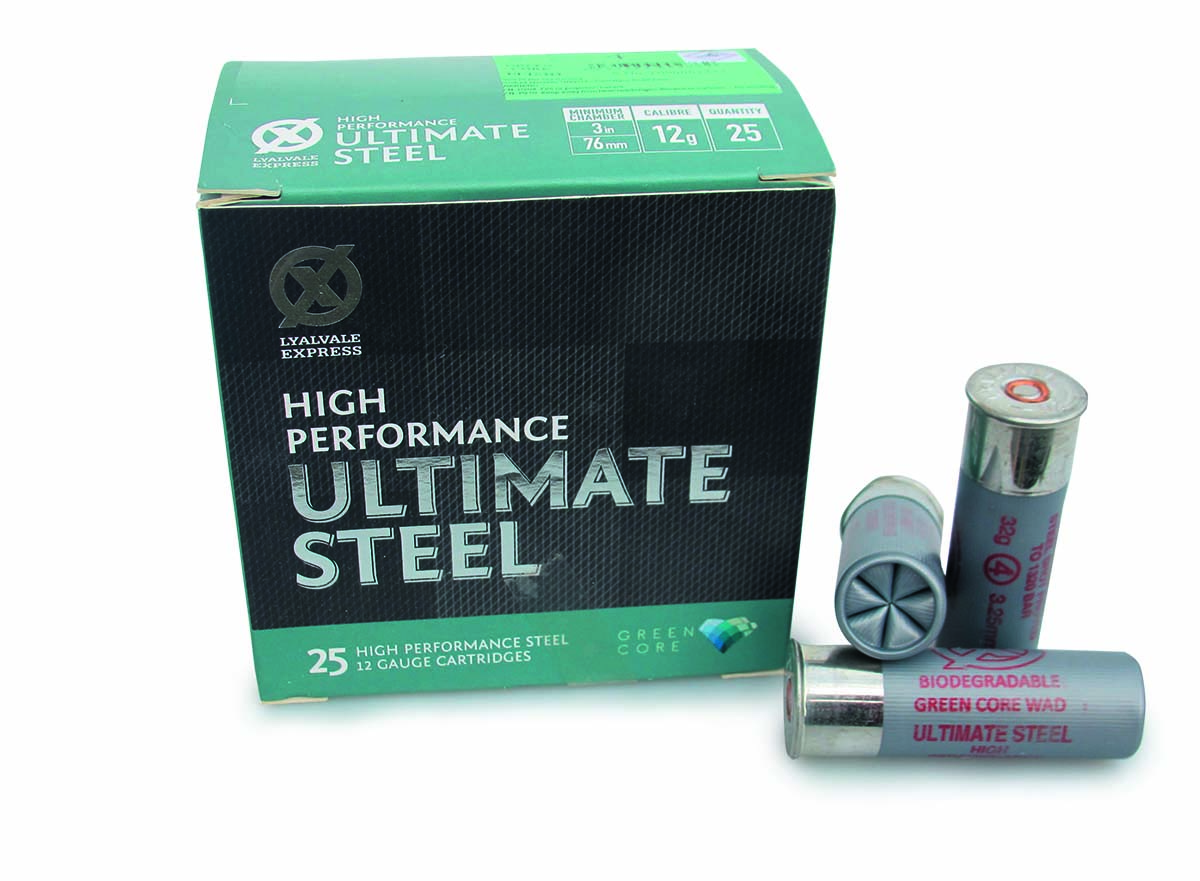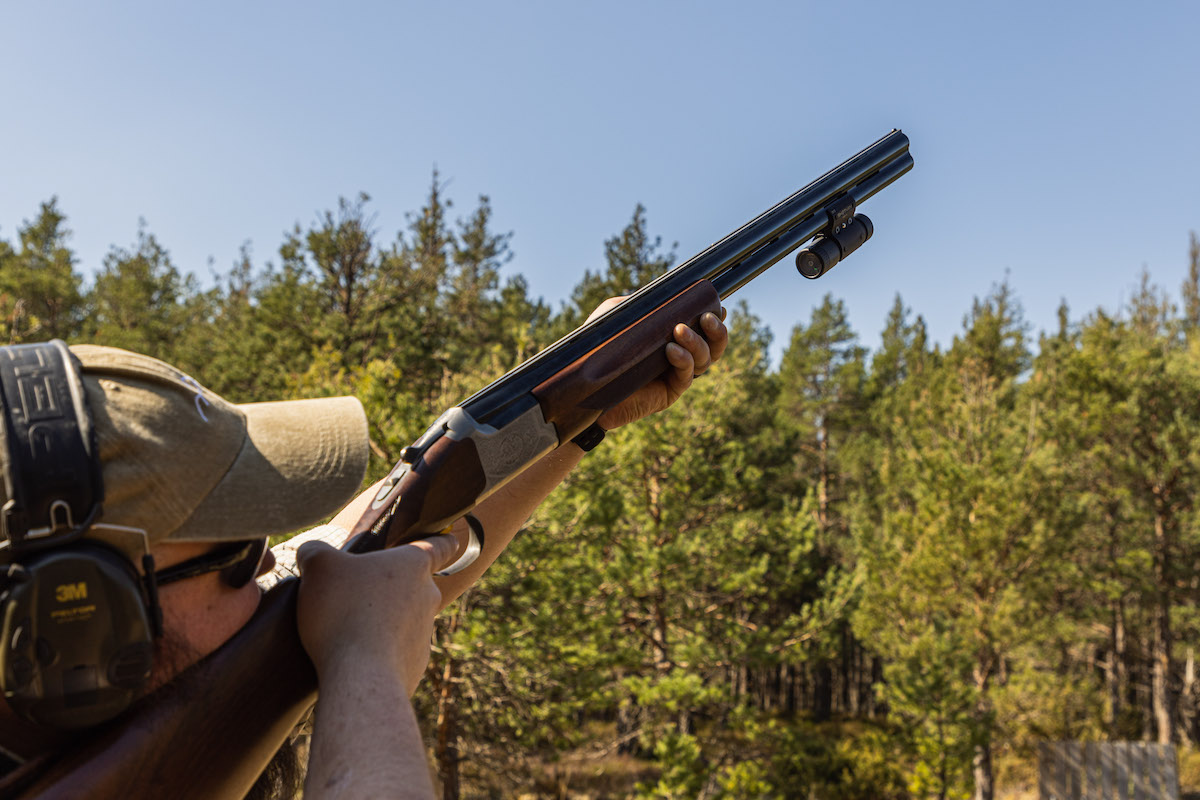Lyalvale Express Ultimate Steel High Performance cartridges on test
Richard Atkins takes a closer look at the Lyalvale Express Ultimate Steel High Performance cartridges

Lyalvale Express Ultimate Steel High Performance cartridges
All four leading UK cartridge companies have clearly been put in an invidious situation as a result of recent calls for change affecting two of the most critical cartridge components: shot material and wads. The call for a transition away from lead shot – to be replaced by a suitable non-lead alternative – was jointly made by nine country sports organisations. This announcement, it would appear, was made without adequate prior meaningful discussion with the companies affected.
To compound matters, this was linked with the need to stop using plastic wads, which have been used in a vast range of cartridges, for a wide range of applications and in the full range of calibres, over many years. Lead shot and HDPE (high-density polyethylene) plastic wads have become central to maximum performance in both game, field and clay target cartridges and hence an incredibly complex requirement for fundamental change has been created, and within an unrealistic time frame. (Read will my gun be safe with steel cartridges?)

The inner components of the Lyalvale Express Ultimate Steel HP cartridges
Cartridge companies are making Herculean efforts to meet these demands but, of course, they face considerable difficulties in meeting both requirements. No company has, for example, great knowledge on biopolymer material for wads, whether biodegradable or water-soluble. From experiences so far, the biopolymers currently used do not all possess the inherent mechanical strength, elasticity or ready ‘mould-ability’ that the long-chain polymers’ inherent characteristics of HDPE polymers rely upon for their tremendous strength.
This is but a brief taster to help shooters understand the massive upheaval foisted upon cartridge companies. Please take these into account when wondering why both choice and supplies are restricted. Prices will also increase, because not only are the new materials very costly to produce, but not all will prove usable. Development costs will mount as suitable materials are sought: these then require new tooling to produce. Cartridge companies face a very testing time. Whether all will cope with the financial implications is something we must sincerely hope is manageable.
With all this in mind, we review here the very latest steel shot game/wildfowl cartridge from Lyalvale Express (recently taken into the Fiocchi fold). Whether the current upheaval played a part in this acquisition by Fiocchi is unclear but would come as no surprise. An obvious advantage of being part of a very large company can be seen with the use of the Fiocchi Green Core biodegradable plastic wad whereas, in Lyalvale’s earlier 65mm 30g Ultimate Steel standard steel cartridge, the brown, biodegradable Earth Wad is used. Two other companies are currently using water-soluble wads; the jury would appear to be out as to which route is the best one to follow.

The top flap of the cartridge box gives a full specification
Ultimate Steel HP
The new high performance (HP) cartridge from Lyalvale Express shares its name with the standard steel option for use in non-steel proof tested and lighter-weight game guns. This HP cartridge permits a slightly higher velocity and the 76mm (3in) case allows for a 25% higher momentum at 15 Newton seconds (Ns) against 12Ns for 12-bore standard steel ammunition. Velocity being only marginally higher than for standard steel, this uplift is of limited value because, being so small and less than the typical difference one often finds from shot to shot, there remains a risk that the limit may be exceeded if approached too closely. This caution does not apply with lead shot cartridges.
The higher momentum limit permits a heavier shot load weight to help maintain energy with the larger pellets demanded for the longer-range quarry usually associated with HP steel cartridges.
Most major brands have usually obtained powders and primers used from particular makers in recent years and, with Lyalvale now owned by Fiocchi, I expected cases and primers to be of Fiocchi origin. However, such has been the turmoil caused by a global shortage of all the components over the past three years or so (and now affected by the war in Ukraine), plus the need to develop powders to suit steel-shot game loads along with bio wads and so on, it has become necessary for cartridge loaders to seek the best product they can from a limited range of suitable types.
This has led to more cooperation between brands and a willingness to source components more widely. The primers in these cases appear to be Cheddite from the lacquer coating, as Fiocchi usually have a paper disc protecting the flash hole. No doubt both cases and primers will be from Fiocchi as supply lines settle down.
The propellant is a square, green, cut flake which appears to be from the French SNPE range. A 30.6-grain average charge puts the velocities comfortably within the CIP limit. Likewise, the 32g shot load came in well inside the 15Ns maximum momentum for this steel cartridge type.
Tight limits on velocity and momentum serve to make the cartridge loader’s task of keeping inside CIP constraints while providing the best performing cartridges for live quarry shooting a difficult balancing act.
No UK cartridge producer makes their own steel shot, which is largely imported from China. This, along with the need to seek shot sizes not previously part of major orders, adds to all cartridge companies’ headaches. The CIP specifying a maximum of 3.25mm for steel shot in 12-bore standard steel cartridges brought a demand for shot of a previously non-standard size; hence we have seen 3.25mm steel shot (with different description, for example 4A) now available in some 12-bore standard steel loads to take advantage of the maximum permissible diameter of steel shot. This is, in fact, the declared diameter for the No 4 shot in these cartridges.
These 76mm Ultimate Steel cartridges are marked ‘high performance’ (as required by the CIP), and the shot size limit goes up for 76mm (3in) HP cartridges to 4mm. It appears Lyalvale applied a similar theory to some others, using a larger shot size, as the average pellet size measured 0.13in. This is size No 3 but is comfortably within CIP specifications. While pellet count will be lower, the striking energy will be higher.
Test standards

Proof
The proof test results are interesting. These show that the breech pressure is actually within the limit of 740 bar for standard steel limits, let alone HP. I have mentioned before that pressures are not the key problem with steel loads (although plenty seem to think they are). Modern propellants are versatile at providing all the velocity required within reasonable pressure limits: this is an example. Momentum is what potentially creates the most problems, especially with larger shot sizes; that’s why momentum, hence shot load weights, are set low for standard steel cartridges.
The proof authorities and the Gun Trade Association both published advice regarding chamber length and cartridges. While we all know not to use cartridges longer than our gun’s chamber length, we have also always known that a shorter cartridge is safe to use, even if patterns might be slightly adversely affected. Updated information has been published suggesting evidence is mounting that some guns have suffered damage to their forcing cones when using steel shot cartridges of shorter case length than the chamber they are fired from.
This is potentially very significant because, over the past 15 years or so, a great many new guns have come with 76mm (3in) chambers as standard. Given that a majority of cartridges sold have, until now, been 70mm (2¾in) – especially clay cartridges where none are 76mm – this could yet be an issue to overcome. Of the 12-bore 32g steel shot cartridges currently available, few are loaded into 76mm cases; could this be another – potentially costly – issue?
Patterns
Patterns are, on the whole, reasonably good. The variation from most to least dense result over six patterns at 40 yards was 11%. This is up with the consistency of good-quality lead loads and better than some. What particularly interests me is the choke equivalent pattern density steel loads achieve. We have routinely read and heard how “steel shot produces full choke patterns from a 1/2 choke barrel”. All I can say is that those who glibly state this as a given have not tested many steel shot cartridges. It may be a handy thing to state, making folk feel better about steel shot, but, so far in my experience with new steel shot loads using biopolymer wads, this has not generally proven the case.
The accepted full choke definition for pattern density is 70% at 40 yards. These cartridges achieved 63% pattern density from a 1/2 Mobil choke. Some chokes may do better; we may check this out in future. However, without qualification the information put out as an accepted fact is actually far from being so. As I always recommend, you must check your gun’s performance for yourself using your choke to check the cartridges you wish to assess.
Steel shot is invariably larger than you would use with lead shot. Two sizes larger is the generally accepted base principle to maintain adequate pellet energy. The snag is this reduces the pellets in the shot charge and, because they may not make full choke patterns, the density they do achieve can lead to thinner than ideal patterns.
These cartridges offer quite a reasonable chance of success within 40 yards. Some tests at 50 yards show patterns beginning to open from 40 yards on – stretching for longer quarry must be done with knowledge and caution and this applies to any new steel shot cartridge. Whatever you may have read on Facebook forums, before attempting stratospheric pheasants please pattern check your gun.
One last point I must mention is of some concern for us all. It’s not the cartridge makers’ fault but steel shot and what it brings with it. That is recoil. This is a topic all its own, so I merely mention it here; but all steel shot cartridges I have fired so far ‘kick’ me more noticeably than their nearest lead shot equivalent. Having very little room for a collapsible centre section in steel shot wads, this small smoothing of the recoil characteristic is lost. Steel shot must also be propelled at high velocity to achieve adequate striking energy, which has a significant effect on felt recoil.
Overall these cartridges performed well. Pattern density is at 63% – just under ¾ choke. Distribution proved generally good but a little less so with the lower results; partly a result of the lower total pellet count for large shot. The impact marks on the pattern plate indicated that pellet energy was more than adequate beyond the effective pattern distance. An interesting cartridge for those with 76mm chambers.

The Green Core fired wads. They are biodegradable but not water-soluble
Performance statistics
- Configuration Lyalvale Express HP Ultimate Steel 76mm 32g No 4 Green Core
- Shot load 500.4 grains
- Pellet (count per oz) 228 UK shot (size/actual) No 3 (3.3mm)
- Pellets in 30in dia (Av) 142
- Pellets in 20in to 30in 60
- Pattern 63%
- CD 58%
- Velocity 421m/sec (1,381fps)
- SD 6
- Recoil (M) 13.47Ns
- Pressure (bar) 724bar








